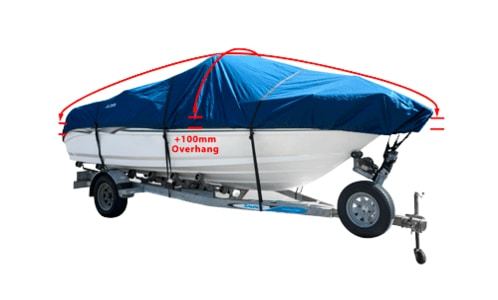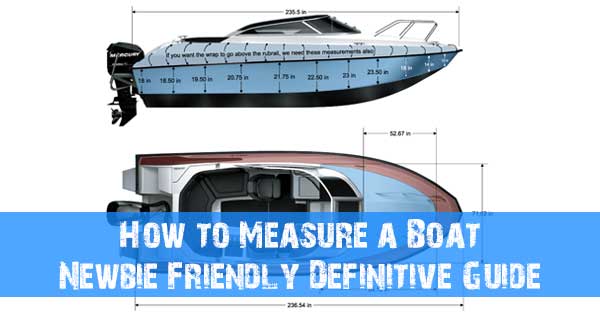Today, we’re going to look at how to measure a boat’s size.
You May Also Like To Read:
- Pontoon Boat Anchor
- Underwater Boat Lights
- High Quality Boat Buffer
Table of Contents
Why measuring a boat matters?
Storage, winterization, transportation, and other activities/functionalities associated with your boat largely rely on its size.
Again, taking your boat’s measurements is legally necessary as you’ll discover.
On more things, suppose you are going to buy a boat cover or boat speaker then you need to know actual size of boat.
What parameters are we going to use for measure a boat perfectly?

There are a number of these, but the most vital ones are 3: total height, the beam, and the length.
Normally, a tape measure will be enough to take the measurements, but an adhesive tape or another person might be of great help by holding the tape as you measure.
We will start with the length.
When measuring the length of the boat, we take the vessel’s full length from the bow all the way to the transom.
Normally, we don’t include attachments on the boat, like the outboard motors, rudders, bowsprits, and swim platforms.
But, some companies might want to include these attachments for transportation logistics. If you’re going to measure the attachments, be sure to take the measurements in a raised position.
Importance of measuring the length of a boat
i. It affects the transportation costs (the bigger the length, the more the costs)
.ii. The length of the boat matters when calculating how much anchor chain you need.
iii. Vessel accommodation cost on marinas partially depends on the length of the boat. As a longer boat takes up more space, its docking charges are higher.
iv. Transportation regulations – boats beyond a certain length might not be permitted on the road at particular times of the day.
v. The method of international transportation – there are several methods, including the following, and the length of the boat matters in deciding on the method to be used:
- Roll on/off – the boat gets efficiently loaded onto the ship’s cradle. This is the most affordable method, which also happens to be one of the safest.
- Lift on/off – a crane is used for loading the boat onto the ship.
- Containerization – the vessel is placed in a container and loaded onto the ship, but only small boats can be transported this way.
- Flat rack – this method is suitable for larger/longer boats. The vessel is placed on a flat rack and loaded onto the ship.
There are several other methods, like submersion, and usually, the length of the boat is used in determining the kind of method to be used.
The Height of the Boat
When assessing the height, we measure the distance from the keel all the way to the vessel’s highest point.
Importance of taking the height:
i. Boat safety – you might have spent lots of money getting that boat, and so it’s only natural that you will seek ways of protecting it.
One thing that you need to know is that a taller boat is at a higher risk of keeling than a short one.
ii. Transport laws – like the length, the height of the vessel determines whether the vessel can be transported by road during particular times.
Mostly, a maximum height of 13.6 feet is allowed, and any height beyond that requires you to get a permit.
In case your boat is over 16 feet, you might be needed to get an interstate clearance.
iii. Routing – there are routes with bridges that are lower than 13.6 feet, such as the Northeast, and thus if your boat is tall, you need to think about the route that you’re going to use.
iv. Transportation costs – taller boats may require special handling during transport, thus attracting extra charges.
The beam
This just refers to the vessel’s width, and it involves taking the length of the vessel’s widest section, which is typically near the middle.
Importance of the beam:
i. Transport laws – legally, a vessel whose width surpasses 8.6 feet is categorized as oversized, and when transporting it by road, you typically have to get a permit.
ii. Insurance – the wider the boat, the more limited the insurance policy for not just the boat but also the vehicle you’re using to transport the boat.
In the event of an accident, you might be required to produce an oversized vessel permit to get compensated.
Collectively, the 3 dimensions (length, height, and beam) are used in determining the shape of the boat, as well as the following factors:
iii. The performance – the vessel’s ability to perform depends on the ratio of the length to the beam, among other aspects.
The larger the ratio, the higher the speed, as the boat faces less resistance from the waves.
iv. Capacity – the capacity is calculated by multiplying the length by the beam, that is, by finding the surface area.
A larger surface area allows you to load more weight onto the vessel.
How to Measure a Boat FAQ
Q1. How do you measure the beam of a boat?
The beam is just another word for the width of the boat, and to measure it, you just go for the widest point on the boat.
Q2. What is the draught of a boat?
Also known as the draft, the draught refers to the vertical distance between the waterline and the lower part of the boat’s hull; it incorporates the hull’s thickness.
This measurement is used in determining the minimum depth of water that the boat can safely sail in.
Q3. How is the length of the boat measured?
You’re supposed to measure along the centerline, from the outer part of the hull aft to the outer part to the hull forward, without measuring any attachments like trolling motors and swim platforms.
The length of the boat is very important when determining the appropriate length of the anchor chain.
Measure your Boat my Final Thoughts
It’s essential that you take the right measurements and report them to the hauling company for transportation purposes.
These measurements are also pretty handy for making your plans, like calculating the amount of anchor chain to use and deciding on the transport routes to use or avoid.
You can also read our guide on how does a boat speedometer work and reviews of trolling motor if you ever plan to buy one.
